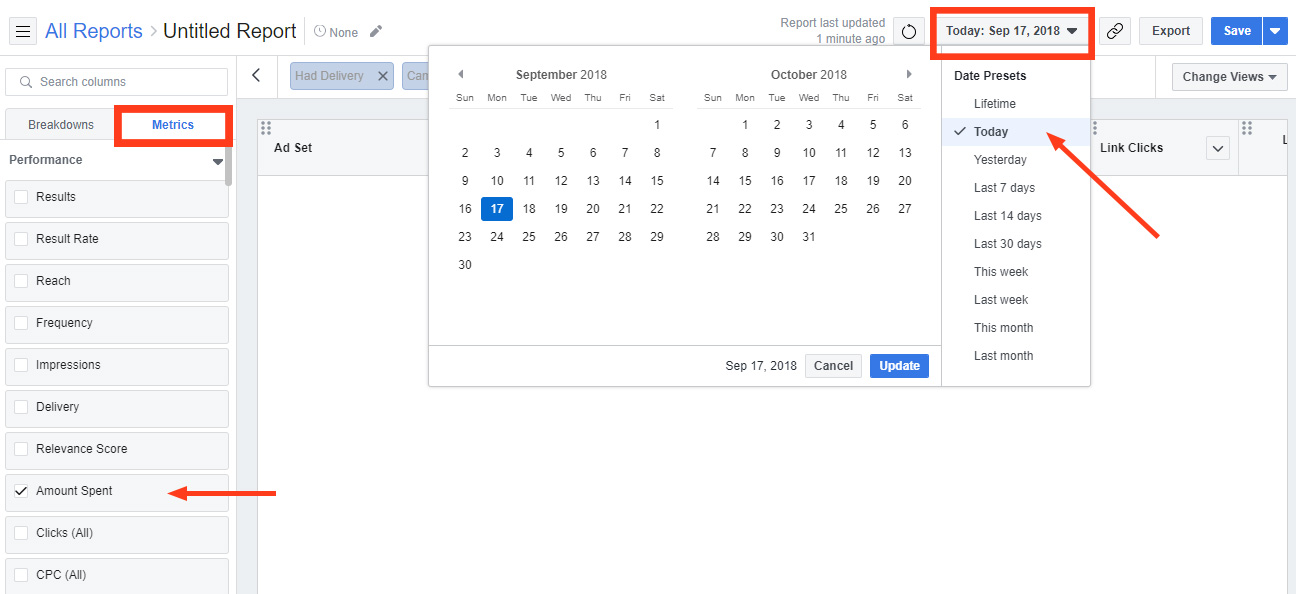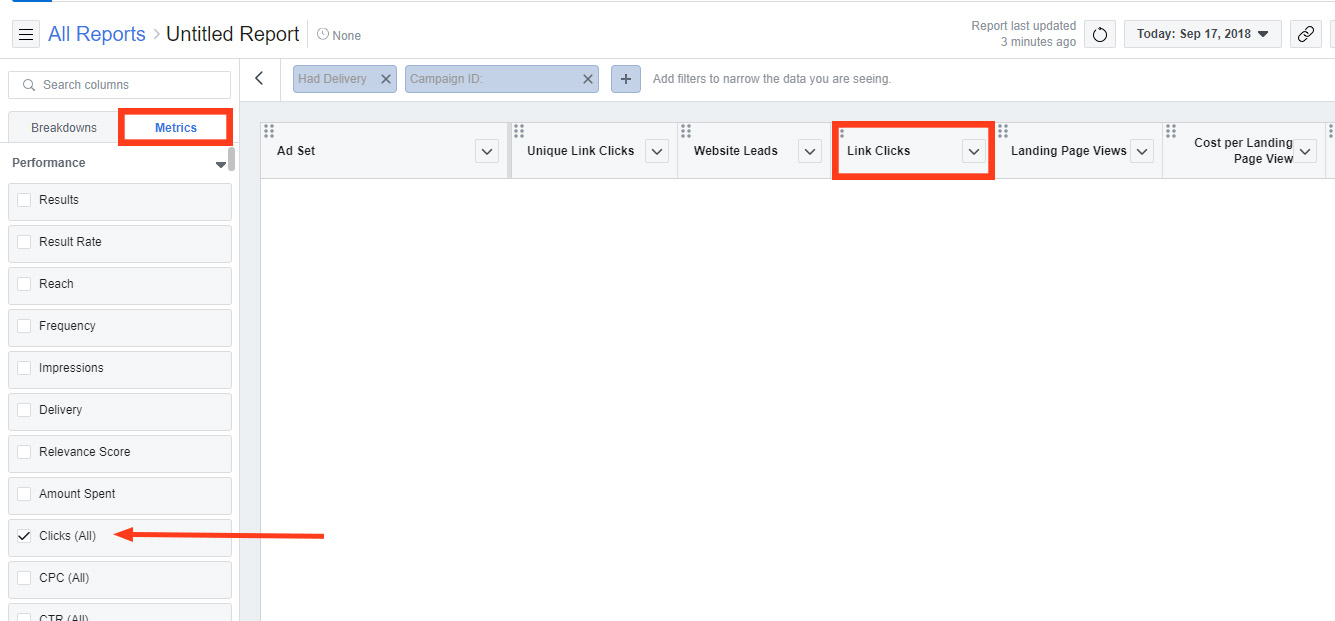This summer, Facebook Ads metrics underwent some changes. Eleven of its metrics were deemed “redundant, outdated, not actionable or infrequently used,” and were removed from the platform. But if you were using any of these metrics to understand your ads’ effectiveness then you’ll need new ways to analyze your data.
Here are the metrics that were removed and the other methods you can use to replace them.
1. Metrics Removed: Actions, People Taking Action, Cost per Any Action
When Facebook first introduced this metric, there were only four ways for your audience to interact with your ads: like, share, comment, or click. All these actions were bundled up into one “Action” metric. But as Facebook creates new ways for audiences to interact with ads, this metric will become too nuanced to be of much value in your reporting.
Replacement Metrics:
You’ll still be able to create your own composite metric based on specific actions. You should decide which types of ad interactions are valuable to your business and create a composite metric of those interactions specifically. It will be much more beneficial to understanding if your ads are reaching your audience in the way you intended.
2. Metrics Removed: Amount Spent Today
This is one of the redundancy issues that Facebook Ads is addressing by removing the “Amount Spent Today” metric. There are other ways to access this data.
Replacement Metrics:

Now if you want to see how much you’ve spent today, go to your reports, select “Today” in the date range selector and in the metrics tab select “Amount Spent”
3. Metrics Removed: Button Clicks
This one also falls into the category of “redundant”. There are other ways to get this data.
Replacement Metrics:

In your reports, go to the Metrics tab and make sure Clicks (All) is selected. Then in your data display, sort by “Link Clicks”.
4. Metrics Removed: Canvas Component Time Percentage
If you use Canvas ads (full-screen ads that appear on mobile devices) then this is one change that may affect you. Facebook grouped together the various ‘components’ of a canvas ad into this one metric, but because relatively few people used it in their reporting they’re getting rid of it.
Replacement Metrics:
With the “Canvas Component Time Percentage” metric being removed, Facebook suggests that ad managers use the “Canvas View Time” and “Canvas View Percentage” metrics in its place.
5. Metrics Removed: Carousel Card
For those who use Carousel ads, it’ll be important to note that Facebook is getting rid of the conversion metrics and CTR for cards.
Replacement Metrics:
The data itself for Carousel Cards is still being collected, you’ll just need to calculate information like CTR manually. You’ll be able to see the data by selecting “Carousel Card” in the Breakdowns tab and have other metrics, like “Link Clicks”, selected in the Metrics tab.
6. Metrics Removed: Link Click Destination
It’s a shame to see this one go. For many businesses, this metric was useful. Because of changes in mobile device operating systems, Facebook can no longer accurately report this metric, making it impractical to track and unreliable in reports.
Replacement Metrics:
If you’re looking to see what clicks lead your audience to pages outside of Facebook, we suggest using “Outbound Clicks” and “Landing Page Views” as the next best thing. Hopefully Facebook will find new ways to measure this metric more accurately in the future.
7. Metrics Removed: Mobile App Actions Conversion Value
This one falls into the realm of “not actionable”. Because there are so many actions taken within an app, it’s better to measure app actions individually instead of all grouped together.
Replacement Metrics:
Facebook has metrics available for specific mobile app action conversions that you’ll be able to select in your reports like “Mobile App Purchase Conversion Value”, “Mobile App Content Views Conversion Value”, “Mobile App Adds to Cart Conversion Value”, etc. Determine which of these conversion rates are most important to your strategy and use them to measure the effectiveness of your ads instead.
8. Metrics Removed: Page Mentions, Cost per Page Mention
According to Facebook, these metrics don’t account for whether page mentions are made in a positive or negative light, and so the metric is therefor “outdated”. Brands might argue that they want to be able to see this information regardless, but they’ll be at a loss from now on.
Replacement Metrics:
The closest thing to the removed “Page Mentions” metric would be the “Page Likes” and “Page Engagement” metrics.
9. Metrics Removed: Page Tab Views, Cost per Page Tab View
This one is a bit of a head-scratcher. Facebook is pretty vague about why they’re removing this metric, saying only that they recommend using other Page-specific metrics. If your business used Facebook Page Tabs in your ads then you may be out of luck determining their effectiveness moving forward.
Replacement Metrics:
We’re at a bit of a loss for this one. Facebook only suggests using “Page Likes” and “Page Engagement”, saying that these metrics are better at determining the success of your campaign than the Tab View metric.
10. Metrics Removed: Positive Feedback, Negative Feedback
Facebook is removing this metric because for one, it’s a bit redundant since these data sets are used to calculate the “Relevance Score” metric, and second these data sets are based on predictive models and estimates. So the results of these metrics aren’t very clear and it’s hard to tell if they’re very accurate.
Replacement Metrics:
If you insist on having this data, then you can still get the overall sense of positive/negative feedback by using the “Relevance Score” metric.
11: Metrics Removed: Social Reach, Social Impressions, Social Clicks (All), Unique Social Clicks (All)
The removal of social-specific metrics is due to the fact that they’re note actionable. Because ad managers can’t control if ads will be seen with social information, having this specific information may be interesting, but there’s nothing you can really do with that information.
Replacement Metrics:
You can still see this information, minus the social aspects, by using “Reach” instead of “Social Reach” and “Impressions” instead of “Social Impressions”.
Are you affected by the recent changes to Facebook Ad Metrics? Do you need help changing your ad strategy? Reach out to us! We’re here to help.

